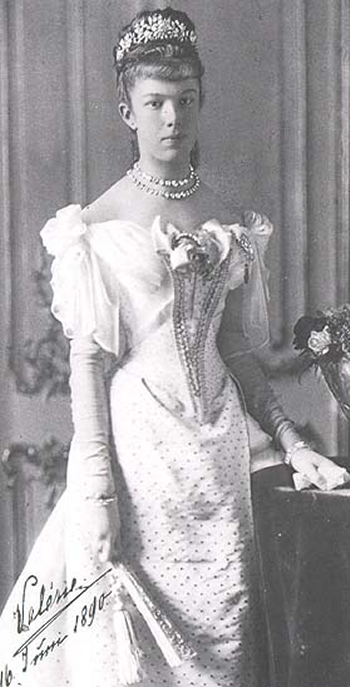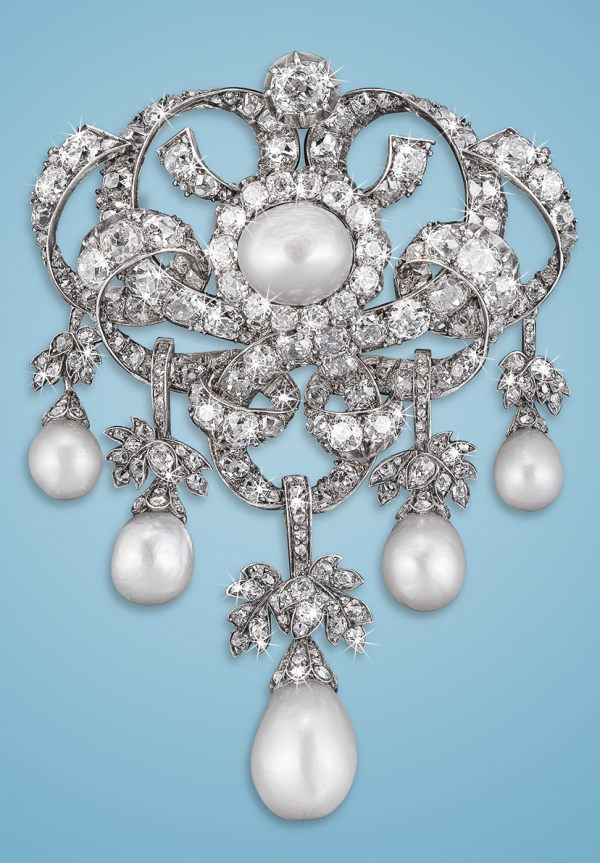 |
| Dorotheum |
At the end of October, an Austrian auction house announced the upcoming sale of an exciting suite of royal jewelry: a tiara and corsage ornament that belonged to the youngest daughter of one of Austria’s last emperors.
 |
| Dorotheum |
Both jewels were made around 1890 by Kochert, the firm that served as court jeweler to the Austrian imperial family. The tiara is set with around 25 carats’ worth of diamonds and 15 pearls, some of them baroque. The large brooch is set with six more pearls and more old-cut diamonds. The tiara was made by Wilhelm Friedrich Haarstrick, one of the managers of the Kochert atelier, while the brooch was constructed by A.E. Kochert himself.
 |
| Archduchess Marie Valerie, ca. 1890 (Wikimedia Commons) |
Both jewels were made around 1890, the same year that their first owner was married. Archduchess Marie Valerie of Austria was the youngest of the four children of Emperor Franz Josef and Empress Elisabeth of Austria. Born a decade later than the rest of her siblings, Valerie was the treasured baby of the family, indulged by her mother and allowed to marry a husband of her own choosing. She selected a second cousin, Archduke Franz Salvator, part of the Italian branch of the Habsburg family. They were officially engaged on Christmas Eve in 1888.
 |
| Marie Valerie and Franz Salvator (Wikimedia Commons) |
But fate and tragedy intervened shortly afterward. A month after Valerie’s engagement was officially announced, Crown Prince Rudolf of Austria killed himself and his mistress, Baroness Mary Vetsera, at his hunting lodge, Mayerling. The death of Rudolf, who was Valerie’s only brother, plunged the family into despair and left the imperial succession perilously resting on the shoulders of a cousin, Archduke Franz Ferdinand. (And we all know how that turned out, sadly.) Valerie stayed by the side of her grieving mother, Empress Elisabeth, for months, postponing her wedding until the summer of 1890.
 |
| Dorotheum |
Valerie and Franz Salvator were finally wed in July 1890, and the wedding presents lavished on the bride were incredible. One newspaper article noted that the display of the gifts took up an entire apartment in the imperial palace, with “three beautiful diadems, with brooches to match” among the splendor. The notes from the auction house do not specify whether this tiara and brooch were among those wedding presents, but the date of their creation certainly makes that a real possibility.
 |
| Dorotheum |
In their report on Valerie’s wedding, the London Times made it clear that Valerie herself was the brightest jewel present on the day: “Little more remains to be said of the wedding except this — that no Archduchess on her marriage day ever carried more truly with her the good wishes of a whole people. The Archduchess Marie Valerie has been her mother’s constant companion and will be most sadly missed by her. To her father she has ever been all that a daughter should be, the delight of his home and his comfort in days of sorrow. A good, brave-hearted girl, gifted with many talents and with a bright, winning face, the young Archduchess deserved to make, as she has made, a pure love match. The other day the Emperor said, with a mixture of joy and sadness, ‘This marriage will be my last happiness.’ Everybody will hope for many years of happiness to the bride, to her husband, and to the parents whom she loves so well.”
 |
| Franz Salvator and Marie Valerie with eight of their children, ca. 1905 (Wikimedia Commons) |
The marriage was a happy one to start. Valerie and Franz Salvator were genuinely in love, and they had ten children together over the following two decades. They raised their family in Schloss Wallsee (which they purchased from Queen Victoria’s second son, Prince Alfred, Duke of Saxe-Coburg and Gotha) on the Danube. But more losses and disappointments followed. Valerie’s mother, Empress Elisabeth, was murdered in Switzerland in 1898. And Franz Salvator turned out to be perhaps not the wisest choice for a spouse after all. He was frequently unfaithful, even formally acknowledging an illegitimate son during his marriage to Valerie.
 |
| Marie Valerie, ca. 1912 (Wikimedia Commons) |
Valerie’s father died in 1916, and at the end of World War I, the Habsburg dynasty in Austria officially ended. Valerie and her family were permitted to keep their home and stay in the country — but only after she formally recognized the end of the monarchy. (She’d already given up her personal succession rights years earlier, as part of her marriage ceremonies.) She died of cancer at Schloss Wallsee in 1924. The tiara and brooch were left to her descendants.
 |
| Dorotheum |
According to the literature provided by the Dorotheum, the tiara and brooch stayed in the family until this year; they are being offered for sale by some of Valerie’s descendants. The tiara is estimated to sell for between 100,000-200,000 euros (about $110,000-$220,000 USD), while the brooch is expected to fetch between 60,000-100,000 euros (around $66,000-$110,000 USD). The auction will be held in Vienna on November 27.
Leave a Reply